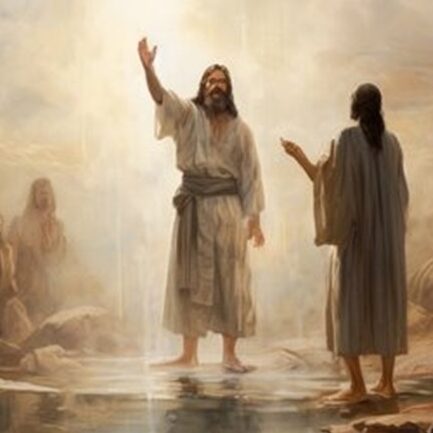John the Baptist taught people the importance of repentance, confession of sins and living a moral life. According to the Gospels, the key teachings of John the Baptist were:
- Repentance: “Repent, for the kingdom of heaven is at hand” (Mt 3:2).
- Confession of sins: People from Jerusalem, Judea and the whole region around the Jordan were coming to be baptized by John as they acknowledged their sins (Mk 1:5, Mt 3:5-6).
- Baptism: John prepared the way of the Lord by baptizing people with “a baptism of repentance for the forgiveness of sins” (Mark 1:4). The baptism of John was a symbol of cleansing and a new way of life; it prepared people for the coming of Christ, who will baptize them with the Holy Spirit. It was different from the Jewish ritual washings (mikveh) due to its emphasis on personal confession and conversion.
- Conversion: “Produce good fruit as evidence of your repentance” (Mt 3:8).
- Against presumption: “Do not presume to say to yourselves, ‘We have Abraham as our father.’ For I tell you, God can raise up children to Abraham from these stones” (Mt 3:9).
- Moral conduct: He called for specific actions from specific people, including:
- Telling the crowds to share their food and clothing: “Whoever has two tunics should share with the person who has none. And whoever has food should do likewise” (Lk 3:11).
- Telling the tax collectors to stop cheating others: “Stop collecting more than what is prescribed” (Lk 3:13).
- Telling the soldiers to be just: “Do not practice extortion, do not falsely accuse anyone, and be satisfied with your wages” (Lk 3:14).
- Imminent judgment: He warned that a judgment was coming, “Even now the ax lies at the root of the trees. Therefore, every tree that does not produce good fruit will be cut down and thrown into the fire” (Lk 3:9).
This Advent Season, which is a time for inward reflection and spiritual preparation, let us take a closer look at the sin of presumption. There are two kinds of presumption: (1) Presuming upon one’s own capacity to save himself without the help of God’s grace (Pelagianism), and (2) Presuming upon God’s mercy to obtain forgiveness without conversion and glory without merit (CCC 2092). The first kind of presumption stems from misjudging one’s own goodness, while the second kind stems from misjudging God’s mercy. Either way, presumption is a grave sin against the virtue of hope (CCC 2091), because if you think that you’re already saved, then there is no need for hope.
The second kind of presumption wrongly presumes upon God’s mercy by expecting forgiveness and salvation without genuine repentance or effort; it makes people believe that they can commit sin freely just because God is merciful; and it makes people believe that they can get to heaven without living a virtuous life.
The sin of presumption manifests itself in the following ways: (1) Committing a sin with the excuse, “I’ll just go to confession later,” (2) Going to confession without genuine sorrow or any firm purpose of amendment, (3) Just as the Jews assumed that they would automatically inherit the kingdom of God because of their lineage from Abraham, some people assume that they will be saved without “works” or any effort on their part because they claim to be Christians. It requires effort to live a Christian life, to strive for holiness and to be in a state of grace.
The consequences of the sin of presumption: (1) It turns God into a tool for personal convenience, (2) It reinforces sinful habits, and (3) It leads one deeper and deeper into spiritual blindness. Ways to counter presumption: (1) Acknowledge your need for God’s grace, (2) Recognize that God’s mercy requires a sincere response, and (3) Actively love God through your actions and not just words.
